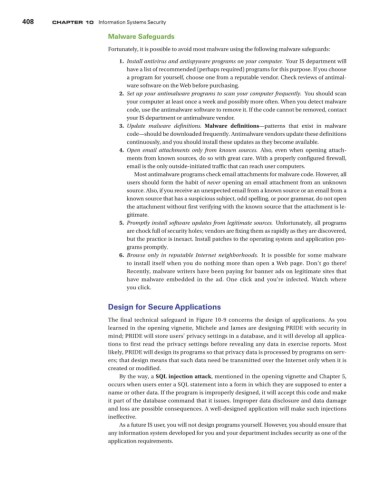Page 440 - Using MIS
P. 440
408 Chapter 10 Information Systems Security
Malware Safeguards
Fortunately, it is possible to avoid most malware using the following malware safeguards:
1. Install antivirus and antispyware programs on your computer. Your IS department will
have a list of recommended (perhaps required) programs for this purpose. If you choose
a program for yourself, choose one from a reputable vendor. Check reviews of antimal-
ware software on the Web before purchasing.
2. Set up your antimalware programs to scan your computer frequently. You should scan
your computer at least once a week and possibly more often. When you detect malware
code, use the antimalware software to remove it. If the code cannot be removed, contact
your IS department or antimalware vendor.
3. Update malware definitions. Malware definitions—patterns that exist in malware
code—should be downloaded frequently. Antimalware vendors update these definitions
continuously, and you should install these updates as they become available.
4. Open email attachments only from known sources. Also, even when opening attach-
ments from known sources, do so with great care. With a properly configured firewall,
email is the only outside-initiated traffic that can reach user computers.
Most antimalware programs check email attachments for malware code. However, all
users should form the habit of never opening an email attachment from an unknown
source. Also, if you receive an unexpected email from a known source or an email from a
known source that has a suspicious subject, odd spelling, or poor grammar, do not open
the attachment without first verifying with the known source that the attachment is le-
gitimate.
5. Promptly install software updates from legitimate sources. Unfortunately, all programs
are chock full of security holes; vendors are fixing them as rapidly as they are discovered,
but the practice is inexact. Install patches to the operating system and application pro-
grams promptly.
6. Browse only in reputable Internet neighborhoods. It is possible for some malware
to install itself when you do nothing more than open a Web page. Don’t go there!
Recently, malware writers have been paying for banner ads on legitimate sites that
have malware embedded in the ad. One click and you’re infected. Watch where
you click.
Design for Secure Applications
The final technical safeguard in Figure 10-9 concerns the design of applications. As you
learned in the opening vignette, Michele and James are designing PRIDE with security in
mind; PRIDE will store users’ privacy settings in a database, and it will develop all applica-
tions to first read the privacy settings before revealing any data in exercise reports. Most
likely, PRIDE will design its programs so that privacy data is processed by programs on serv-
ers; that design means that such data need be transmitted over the Internet only when it is
created or modified.
By the way, a SQL injection attack, mentioned in the opening vignette and Chapter 5,
occurs when users enter a SQL statement into a form in which they are supposed to enter a
name or other data. If the program is improperly designed, it will accept this code and make
it part of the database command that it issues. Improper data disclosure and data damage
and loss are possible consequences. A well-designed application will make such injections
ineffective.
As a future IS user, you will not design programs yourself. However, you should ensure that
any information system developed for you and your department includes security as one of the
application requirements.

